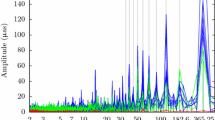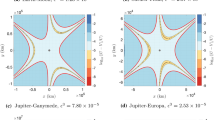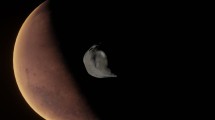Abstract
One of the limiting factors in the determination of gravity field solutions is the spatial sampling. Especially during phases, when the satellite repeats its own track after a short time, the spatial resolution will be limited. The Nyquist rule-of-thumb for mapping geopotential functions of a planet, also referred to as the Colombo–Nyquist rule-of-thumb, provides a limit for the maximum achievable degree of a spherical harmonic development for repeat orbits. We show in this paper that this rule is too conservative, and solutions with better spatial resolutions are possible. A new rule is introduced which limits the maximum achievable order (not degree!) to be smaller than the number of revolutions if the difference between the number of revolutions and the number of nodal days is of odd parity and to be smaller than half the number of revolutions if the difference is of even parity. The dependence on the parity is reflected in the eigenvalue spectrum of the normal matrix and becomes especially important in the presence of noise. The rule is based on applying the Nyquist sampling theorem separately in North–South and East–West direction. This is only possible for satellites in highly inclined orbits like champ and grace. Tables for these two satellite missions are also provided which indicate the passed and (in case of grace) expected repeat cycles and possible degradations in the quality of the gravity field solutions.









Similar content being viewed by others
References
Albertella A, Sansò F, Sneeuw N (1999) Band-limited functions on a bounded spherical domain: the Slepian problem on the sphere. J Geod 73(9):436–447. doi:10.1007/PL00003999
Bender P, Wiese D, Nerem R (2008) A possible dual-GRACE mission with 90 degree and 63 degree inclination orbits. In: ESA, ESA/ESTEC (eds) 3rd International Symposium on Formation Flying, Missions and Technologies. Noordwijk, The Netherlands
Bezděk A, Klokočník J, Kostelecký J, Floberghagen R, Gruber C (2009) Simulation of free fall and resonances in the GOCE mission. J Geodyn 48(1):47–53. doi:10.1016/j.jog.2009.01.007
Bezděk A, Klokočník J, Kostelecký J, Floberghagen R, Sebera J (2010) Some Aspects of the orbit selection for the measurement phases of GOCE. In: Proceedings of ESA Living Planet Symposium, Bergen, Norway
Colombo O (1984) The global mapping of gravity with two satellites, In: Netherlands Geodetic Commission, in publications on Geodesy, vol 7(3). http://www.ncg.knaw.nl/eng/publications/geodesy.html
Flechtner F, Dahle Ch, Neumayer K, König R, Förste Ch (2010) The release 04 CHAMP and GRACE EIGEN gravity field models. In: Flechtner F, Gruber Th, Güntner A, Mandea M, Rothacher M, Schöne T, Wickert J (eds) System earth via geodetic-geophysical space techniques. doi:10.1007/978-3-642-10228-8_4
Han S, Jekeli C, Shum C (2004) Time-variable aliasing effects of ocean tides, atmosphere, and continental water mass on monthly mean GRACE gravity field. J Geophys Res 109(B04):403. doi:10.1029/2003JB002501
Heiskanen W, Moritz H (1967) Physical geodesy. W.H. Freeman and Company, San Francisco
Ilk K, Flury J, Rummel R, Schwintzer P, Bosch W, Haas C, Schröter J, Stammer D, Zahel W, Miller H, Dietrich R, Huybrechts P, Schmeling H, Wolf D, Riegger J, Bardossy A, Güntner A (2005) Mass transport and mass distribution in the Earth system, 2nd edn. Geo Forschungs Zentrum Potsdam, Proposal for the German Priority Research Program
Jekeli C (1999) The determination of gravitational potential differences from satellite-to-satellite tracking. Celest Mech Dyn Astron 75: 85–101. doi:10.1023/A:1008313405488
Johannessen J, Aguirre-Martinez M (1999) Gravity field and steady-state ocean circulation mission. Tech Rep SP-1233(1), ESA—European Space Agency
Kim M (1997) Theory of satellite ground-track crossover. J Geod 71(12):749–767. doi:10.1007/s001900050141
Klokočník J, Kostelecký J, Li H (1990) Best lumped coefficients from resonances for direct use in earth gravity field modelling. Bull Astron Inst Czechosl 41(1):17–26
Klokočník J, Wagner C, Kostelecký J, Bezděk A, Novák P, McAdoo D (2008) Variations in the accuracy of gravity recovery due to ground track variability: GRACE, CHAMP, and GOCE. J Geod 82(12):917–927. doi:10.1007/s00190-008-0222-0
Pavlis N, Holmes S, Kenyon S, Factor J (2008) An Earth gravitational model to degree 2160: EGM2008. In: 2008 General Assembly of the European Geosciences Union, Vienna, Austria
Prange L (2010) Global gravity field determination using the GPS measurements made on board the Low Earth Orbiting Satellite CHAMP, Ph.D. thesis, University of Berne
Schrama EJO (1989) The role of orbit errors in processing of satellite alitmeter data. Tech Rep 33, Netherlands Geodetic Commission
Schrama EJO (1990) Gravity field error analysis: application of GPS receivers and gradiometers on low orbiting platforms. In: Technical Memorandum 100769. NASA: Goddard Space Flight Center
Schrama EJO (1991) Gravity field error analysis: applications of global positioning system receivers and gradiometers on low orbiting platforms. J Geophys Res 96(B12):20041–20051. doi:10.1029/91JB01972
Sneeuw N (2000) A semi-analytical approach to gravity field analysis from satellite observations. Reihe C 527:DGK
Sneeuw N, van Gelderen M (1997) The polar gap. In: Sansò F, Rummel R (eds) Geodetic boundary value problems in view of the one centimeter geoid, Lecture Notes in Earth Sciences, vol 65, Springer, Berlin, pp 559–568. doi:10.1007/BFb0011717
Sneeuw N, Gerlach Ch, Švehla D, Gruber Ch (2003) A first attempt at time-variable gravity field recovery from CHAMP using the energy balance approach. In: Tziavos I (ed) Gravity and Geoid: Proceedings of 3rd Meeting of the International Gravity and Geoid Commission, Thessaloniki, pp 237–242
Sneeuw N, Gerlach C, Földváry L, Gruber T, Peters T, Rummel R, Švehla D (2005) One year of time-variable CHAMP-only gravity field models using kinematic orbits. In: Sansò F (ed) A window on the future of geodesy, International Association of Geodesy Symposia, vol 128, Springer, Berlin, pp 288–293. doi:10.1007/3-540-27432-4_49
Tapley B, Bettadpur S, Ries J, Thompson P, Watkins M (2004) GRACE measurements of mass variability in the Earth system. Science 305:503–505. doi:10.1126/science.1099192
Visser PNAM, Sneeuw N, Reubelt T, Losch M, van Dam T (2010) Space-borne gravimetric satellite constellations and ocean tides: aliasing effects. Geophys J Int 181(2):789–805. doi:10.1111/j.1365-246X.2010.04557.x
Visser PNAM, Schrama EJO, Sneeuw N, Weigelt M (2012) Dependency of resolvable gravitational spatial resolution on space-borne observation techniques. In: Kenyon S, Pacino M, Marti U (eds) Geodesy for Planet Earth: Proceedings of the 2009 IAG Symposium, International Association of Geodesy Symposia, Buenos Aires, Argentina, vol 136, Springer, Berlin, pp 373–379. doi:10.1007/978-3-642-20338-1_45
Wagner CA, Klosko SM (1977) Gravitational harmonics from shallow resonant orbits. Celest Mech Dyn Astron 16(2):143–163. doi:10.1007/BF01228597
Wagner CA, McAdoo D, Klokočník J, Kostelecký J (2006) Degradation of geopotential recovery from short repeat-cycle orbits: application to GRACE monthly fields. J Geod 80(2):94–103. doi:10.1007/s00190-006-0036-x
Weigelt M, Sideris MG, Sneeuw N (2009) On the influence of the ground track on the gravity field recovery from high-low satellite-to-satellite tracking missions: CHAMP monthly gravity field recovery using the energy balance approach revisited. J Geod 83(12):1131–1143. doi:10.1007/s00190-009-0330-5
Yamamoto K, Otsubo T, Kubo-oka T, Fukuda Y (2005) A simulation study of effects of GRACE orbit decay on the gravity field recovery. Earth Planets Space 57(4):291–295
Acknowledgments
We like to thank Dr. Adrian Jäggi for providing seven years of champ data. We would also like to thank the German Space Operations Center (GSOC) of the German Aerospace Center (DLR) for providing continuously and nearly 100 % of the raw telemetry data of the twin grace satellites. We also like to thank J. Kusche and J. Klokočnik as well as two anonymous reviewers for their helpful comments and suggestions.
Author information
Authors and Affiliations
Corresponding author
Appendices
Appendix A: Equator crossings
This appendix gives the general description for the dependency on the parity. In Sect. 2.1, the relation between one descending and all ascending arcs was used. This general description relates all descending to all ascending arcs. Consider again a circular orbit and an arbitrarily located equator crossing of an ascending arc at longitude \(\lambda ^\mathrm{a}_0\). The equator crossing of the \(p\)th ascending arc can then be found by:
Starting from \(\lambda ^\mathrm{a}_0\), the location of the first (in the timely sense) equator crossing of a descending arc is shifted by \(180^{\circ }\) minus the angle passed by the Earth during the traveling of the satellite from equator crossing of the ascending to one of the descending arc. The equator crossings of the \(q\)th descending arc is then given by:
Similar to \(p\), \(q\) refers also to the East–West numbering of the equator crossing of the descending arcs and not to their timely occurrence.
The equator crossings of ascending and descending arcs will coincide if a set of \((p,q)\) can be found for which the difference of ascending and descending arcs becomes zero:
Inserting Eqs. (20) and (21) yields
The absolute bracket is added because the difference \(\left(\beta - \alpha \right)\) will always be positive. Since all quantities are integer values, Eq. (23) has only a solution in case of even parity of \(\left(\beta - \alpha \right)\).
Appendix B: Condition number
Rights and permissions
About this article
Cite this article
Weigelt, M., Sneeuw, N., Schrama, E.J.O. et al. An improved sampling rule for mapping geopotential functions of a planet from a near polar orbit. J Geod 87, 127–142 (2013). https://doi.org/10.1007/s00190-012-0585-0
Received:
Accepted:
Published:
Issue Date:
DOI: https://doi.org/10.1007/s00190-012-0585-0




